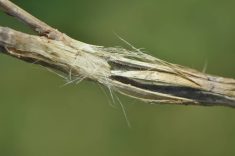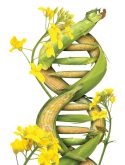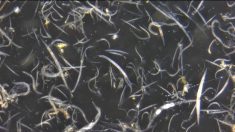Someday distinctly green kernels in canola and sprout damage in wheat may no longer be grading factors.
The hope is instruments in elevators will be able to precisely measure the chlorophyll content in canola and the falling number in wheat. Those are the real degrading factors end-users are trying to uncover by counting distinctly green kernels in canola and sprout damage in wheat.
“The more objectiveness we can put in the better it is over all,” Randy Dennis, Canada’s chief grain inspector with the Canadian Grain Commission (CGC) , said in a re c ent interview.
Read Also

Precision 4R cuts farm greenhouse gas emissions
Lower areas in your field tend to emit more greenhouse gas, research shows that precision 4R nutrient stewardship practices can help mute the trend
The CGC is studying the effectiveness of using Near Infrared Reflectance Spectroscopy (NIR) to measure chlorophyll in canola.
“There’s a lot of promise with this going forward,” Dennis said.
Too much chlorophyll in canola seed affects the colour of the oil, requiring extra effort by crushers to remove.
The CGC is checking the accuracy of the DICKEY-john Instalab 600. Machines have been placed in three primary and two terminal elevators. The CGC is comparing the results with its own.
The CGC also continues to look for a way to measure the enzyme amylase in wheat, which is released when sprouting occurs. Higher alpha-amylase content in wheat flour reduces its bread-making quality.
Rapid Visco Analysis (RVA) machines, which are expensive, are often used in laboratories by trained technicians to measure the amount of alpha-amylase in wheat, but after testing them in elevators the CGC concluded they weren’t accurate enough.
The CGC is now evaluating two other ways to assess the falling number in wheat, which is an internationally recognized measure used to determine amylase levels and ultimately its bread-making quality.
The falling number is the time it takes a plunger to fall through a slurry of flour and water. The faster it falls, the poorer the bread-making quality.
The CGC is assessing two other rapid tests to determine the falling number in wheat. One is an ELISA-based system – a diagnostic tool used to detect enzymes like those released when a kernel begins to sprout.
The other is a hyperspectral imaging system. It can be used to see sprout damage invisible to the human eye.
The CGC is also completing a comprehensive study of the relationship between fusariumdamaged kernels and deoxynivalenol (DON) in all classes of western Canadian wheat. Different types of fusarium may produce different levels of DON, the CGC website says.
Grading tolerances for fusarium- damaged kernels are set in relationship to the levels of DON within the grain.
Researchers are also evaluating instruments that can rapidly determine DON levels in grain. The Western Standards Committee (WSC) has a working group to examine this issue. It wants to be sure if such machines are used in elevators they are accurate.
The WSC has recommended the CGC review the current maximum moisture level content for beans. Researchers will study how bean moisture affects bean storage. Currently, the maximum straight moisture level for beans is 18 per cent.
The WSC also wants the CGC to offer information sessions about how pulse crops are graded. [email protected]
———
“Themoreobjectivenesswecanputinthebetteritisoverall.”
– RANDY DENNIS
———
Grain And Oilseed EndingStocks Up
Commodity News Service Canada Inc.
Ending stocks of Canada’s grain and oilseed crops at the end of 2010-11 will be higher than what was projected in mid-October but still below the level forecast for 2009-10, according to updated supply/demand tables from Agriculture and Agri-Food Canada’s market analysis division released on December 15.
Ending stocks of the eight major grains and oilseeds in 2010- 11 were forecast at 11.65 million tonnes. This compares with the October 14 projection of 10 million and the 2009-10 carryover estimate of 16.18 million.
Production of the eight major grains and oilseeds in 2010- 11 was pegged at 61.8 million tonnes. This compares with the October output forecast of 59.08 million tonnes and the 66.18 million seen in 2009-10. The eight major grains and oilseeds include: canola, flaxseed, soybeans, wheat, oats, barley, corn and rye.
———
Folicur label expanded
Staff
Bayer CropScience’s wheat crop fungicide Folicur has been reformulated and rebranded for use on oat and barley crops.
The new formulation, dubbed Folicur EW, is registered to suppress fusarium head blight and control assorted foliar diseases such as rust, tan spot and septoria leaf blotch, the company said in a recent release.
Growers using the tebuconazole fungicide’s new formulation “will get the same proven leaf and head disease protection of Folicur but now they don’t have to add a surfactant,” Graham Hastie, manager of cereal crop fungicides for Bayer’s Calgarybased Canadian crop protection wing, said in the release.
The new formulation is registered in barley for use against net blotch, spot blotch, scald, powdery mildew, septoria leaf blotch and leaf, stem and stripe rust. In oats, the product can be applied against crown rust and stem rust.
Folicur EW is expected to be available from participating retailers across Western Canada for the 2011 growing season.



















